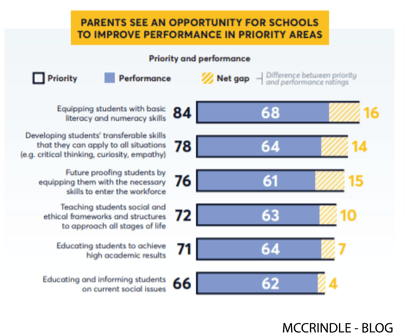The Top Five Future Trends in Education - Can They be Considered Strategic Risks?
.jpg)
According to Mccrindle, in their recent blog and in their Education Future Report and Infographic (Report), the top five trends in education in 2020 are:
- rising parent engagement
- the wellbeing focus
- preparing students for an unknown future
- complexity in education
- attracting and retaining the emerging generation of teachers.
The Report summarises the key trends affecting the education sector, to equip school leaders and teachers for strategic decision-making. The data was collected from surveys conducted in early March with just over 1000 parents and throughout most of March with just over 400 educators. A further survey in relation to teaching in the COVID-19 pandemic was conducted in late April.
Rising Parent Engagement
It was noted in School Governance earlier this year that parental engagement with schools was increasing. We argued that schools should maintain or continue to develop the positive school/family relationships that have been created during the period of online schooling. Prior to this year, a general perception in many schools was that a great deal of responsibility for the education of children had moved from being an equal partnership into a more imbalanced model with schools picking up the tab. The COVID-19 pandemic and the resulting educating of children in a digital teaching and learning environment from home have changed this, with parents more engaged in their children’s learning journeys.
The Report noted that in the last two years, 41 per cent of parents had become more engaged with their child’s school. It reported that “this increased engagement is reflective of a shift in priorities, with almost half (46%) making it more of a priority to engage with their child’s schooling”.
However, teachers surveyed advised that they were feeling the pressure of this increased engagement with 60 per cent of parents expecting weekly communication about their child and one in every 14 parents expecting daily communications.
Schools welcome parent engagement but there needs to be a balance sought so that teachers can spend their time teaching rather than having to provide excessive parental feedback – often at the commencement of the day when classes should be settled and getting ready to learn.
The Wellbeing Focus
In the area of student wellbeing, the Report noted that within the last five years, 48 per cent, or nearly half of all the parents surveyed, have increased their expectations of their child’s school to support student wellbeing. They noted that more than one quarter of all parents have increased their expectations-some quite significantly.
The Report also noted that almost 97 per cent of parents surveyed believed that schools should have a holistic focus and play some role in the management of wellbeing. Nearly 50 percent believed that schools should provide individualised support for wellbeing but also refer on to other experts. School Governance has noted that, in addition to this increase in expectations, schools have had to work out how to assist students to maintain wellbeing and how to support them during periods of social isolation.
In 2017, School Governance reported that schools such as Sydney’s Kambala and Knox Grammar School had engaged directors or deans of wellbeing, while others, such as Perth’s Presbyterian Ladies’ College and Victoria’s Geelong Grammar, had built wellness centres that promoted student wellbeing.
The aim of these wellness centres is to teach students coping and resilience skills by offering a variety of facilities such as meditation and contemplative rooms, Pilates and yoga studios, consulting rooms for visiting specialists, swimming pools and dedicated areas for positive nutrition. Michael Carr-Greg, a leading and well known Australian psychologist has stated that “there is a key connection between wellbeing and learning" and the South Australian Department for Education and Child Development believes young people with good wellbeing are more engaged and successful learners.
There is no doubt that schools are promoting the social and emotional development and wellbeing of their students, to improve overall confidence, resilience and emotional intelligence, which, in turn, will lead to students not only performing better academically but who will forge stronger bonds and lead healthier lifestyles. The issue is, to what extent will schools also be expected to manage student wellbeing?
Preparing Students for an Unknown Future
No principal has a crystal ball that can tell them exactly what the future holds for their students. What is apparent, however, is that the students of 2020 are being equipped with digital skills and adaptability far greater than that of just one generation ago. Alvin Toffler (the author of “Future Shock”) was quoted as saying that “the illiterate of the twenty first century will not be those who cannot read and write, but those who cannot learn, unlearn, and relearn.”
 According to The Learner’s Way, the first industrial revolution resulted in the replacement of human labour by machines; the next is expected to remove humans from much of the cognitive labour that we currently perform.
According to The Learner’s Way, the first industrial revolution resulted in the replacement of human labour by machines; the next is expected to remove humans from much of the cognitive labour that we currently perform.
Schools no longer just teach the facts and figures that so many parents (and grandparents) saw as an integral component of their school learning. There is so much information available today, and so much changing on a daily basis, that schools, although they still teach to the requirements of the Australian Curriculum, now focus, according to the Report, on “developing 21st century skills for lifelong learning in Australian students”.
Parents believe that students need to be equipped with digital skills and creativity. Parents also believe that their children are being equipped with curiosity and adaptability, but they feel there is room to improve in leadership skills.
Complexity in Education
Australian schools, according to Education Minister Dan Tehan, are struggling under the burden of more and more being added to an already overcrowded curriculum. At an education conference at the Australian National University in 2019, Tehan noted that he had received a clear message from teachers and parents around the country that “the curriculum is overcrowded and that means we are sacrificing quality for quantity”.
The Report noted that principals are seeing the educational sector trends towards complexity. This is not in relation to the education that needs to be provided to their students but also in relation to governance and growing compliance requirements and the raft of documentation that goes with those compliance requirements.
In an OECD paper in 2013, it was noted that “the complex nature of educational governance, involving myriad layers and actors, can be an overwhelming problem with no clear entry point for policy makers”.
A quote from a teacher within the Report was: “There is more demand for caring for the students and mental illness. Increase in red tape to uphold accreditation, take time away from the important stuff – managing mental health, caring for their wellbeing when mental health is on the rise. Balancing the two is a challenge definitely.”
Attracting and Retaining the Emerging Generation of Teachers
There has been a number of articles in School Governance over the years about retaining quality school leaders. Two of these (How can we attract and retain quality school principals when 70 per cent may retire in the next five years - Part One and Part Two) can be found here (Part One) and here (Part Two).
The Report has identified that there is also concern in relation to the dropout rate of teachers, and how to continue to attract teachers in an increasingly flexible world of work. While teachers enter the profession for multiple reasons, the key driver behind their decision is to make a difference in the lives of their students. If you ask them, teachers will invariably tell you that to help children to learn and succeed in life is the core of what it means to be a teacher. This is the driving force that retains them when the going gets tough. However, Stephen Harris, in the Report was quoted as saying: “The dropout rate of young teachers worries me because it shows that there’s a growing incompatibility between the culture of expectation and what they would like to do as educators.”
According to another OECD Report: “The quality of teaching is one of the most important factors in the pupils’ learning. This quality is not only determined by the teachers’ professional skills – important though they are – but also by the teachers’ conditions. Good teachers become better teachers if they are offered relevant support and challenges, and if their effort is appreciated”.
In 2015, School Governance noted that many teachers were looking to leave the profession. Five years on and teachers will tell you that they feel under even more pressure now. With greater expectations of parents to provide regular (sometimes daily) reports regarding their children’s educational progress, a very crowded curriculum, greater issues regarding complexity of compliance and the pressure of managing multiple student wellbeing issues as well as classroom learning and their own health, many teachers are now experiencing elements of burnout.
All schools should develop strategies to improve the support and wellbeing of their staff, including managing expectations from the school community.
Conclusion
To quote the Report: “Educators believe in the education sector”. Teachers do what they do because they believe in preparing the next generation of our society. They want to leave more than a digital footprint. They want to make a difference in the lives of their students.
Basically, most teachers are not in it for the holidays-just ask them. The holidays are often seen by the general public as one of the ‘perks’ of being a teacher. The public largely has little knowledge of the preparation, programming, assessment and communication that takes place after hours every day and also during these ‘holidays’.
Thankfully, the Report noted that 88 per cent of the surveyed parents are satisfied with their child’s schooling experience, with almost 50 per cent being extremely or very satisfied.
The Report also noted that sentiment towards the education sector is positive with parents being four times more likely to believe that the school their child attends will be better in the future than worse. Teachers and school leaders are even more optimistic about the school they work in, being 12 times more likely to believe it will be better (rather than worse) in five years’ time.
Read More about Strategic Risk
Click here to read, "Top Operational and Strategic Risks for Schools in 2020" and access a free checklist for schools.
About the Author

Craig D’cruz
Resources you may like
Article
Cyber security and AI in schools: emerging risks and governance imperatives
In an era where artificial intelligence (AI) tools are becoming as commonplace as calculators once...
Read MoreArticle
Under 16 social media 'ban’: an explainer for schools
The Australian Government passed a new law called the Online Safety Amendment (Social Media Minimum...
Read MoreArticle
Risk management essentials for schools
Schools face an increasingly complex landscape of risks every day; from safety hazards on school...
Read More
